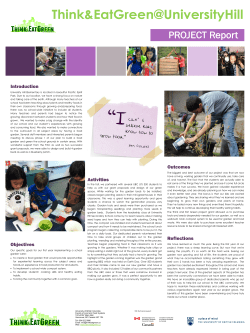
Is your garden green? y How to be kind to your garden www.bcb.uwc.ac.za/envfacts
gard en i n g fo r t h e enviro nment Is your garden green? How to be kind to your garden by Gavin Maneveldt, University of the Western Cape, adapted from The Enviro Facts Project (www.bcb.uwc.ac.za/envfacts) Online Facts maintained by Jocelyn Collins ABOVE: Don’t spray harmful chemicals. Encourage birds into your garden, and let the shrikes and thrushes take care of the caterpillars. Photo: C. Voget. Y ears ago, there was plenty of open, natural veld surrounding our towns and it was rich in wildlife. As towns expanded the natural veld and wildlife shrank into patches between towns, factories and farm land. With this reduction in natural areas, suburban gardens now form an important place where wild animals can live and indigenous plants can flourish. There are many things that one can do to be an ‘environmentally friendly’ gardener. Avoid harmful chemicals All gardens have problem animals that damage plants. Although pesticides will kill them, they may also kill harmless animals such as birds, spiders, lizards and other creatures that are helpful to gardeners. There are many ways of getting rid of pests without killing helpful animals or harming your garden. Strong smelling herbs will act as natural repellents for many unwanted little animals. Chives and garlic planted in a rose garden will keep aphids away. Marigolds help to keep soil clear of nematode worms. The strong smell of rosemary, nasturtiums, peppermint, sage and basil is known to keep many flying insects and ants away. To make a good caterpillar spray, crush half a cup of garlic cloves and add this to one litre of water. Allow to stand for two days. Dilute 222 VELD&FLORA | DECEMBER 2008 the mixture 1:50 with water. Spray the diluted mixture on the leaves of affected plants. To get rid of scale insects, scrub the leaves with a strong washing-up solution and a soft nail brush - or wipe with methylated spirits, removing the cemented-on scales with your fingernail. A good general purpose garden spray will chase pests away without killing them. To 20 litres of water add 1 tbsp bicarbonate of soda, 2 tbsp Jeyes Fluid, 1/5 of a bar blue mottled soap (flaked) and stir well to dissolve all ingredients. Whatever spray you use, choose one that breaks down quickly, and then apply it at dusk so that it will have decomposed by the morning and will not harm bees and butterflies. Encourage creatures to your garden that will prey on the ‘pests’. For example, ladybirds eat aphids; shrikes and thrushes feed on grasshoppers, worms and caterpillars; and hadedahs enjoy crickets. Care for the soil Soil is alive! Hundreds of thousands of living creatures and microscopic plants are found in soil. Earthworms, insects, millipedes, bacteria, algae, fungi and lichens all make soil their home. In turn, they contribute to the development of healthy soil that is able to nourish the plants that grow in it. Add compost: it will add nutrients to your soil, provide a habitat for many soil-living plants and animals as well as keep the soil moist, because it holds water like a sponge. Making your own compost is a very rewarding process, and an excellent way in which to recycle kitchen waste such as vegetable peels, (not potato peels as they can carry eelworm), egg shells and fruit skins. Rotate the plants that you grow in a particular bed. Don’t kill earthworms (artificial fertilizers can drive earthworms away) as they aerate the soil and carry humus from the upper to the lower layers of soil. Use artificial fertilizers only to supplement - NOT replace - natural recycling (the use of compost) in the soil. Encourage indigenous plants Indigenous plants are those that are native to a particular area. An exotic plant is one that has been introduced into an area. One of the many problems associated with exotic plants is that some of them are invasive - this means that they will ‘invade’ indigenous vegetation and displace it. By planting indigenous species you can help conserve our rich plant heritage. In addition, birds and other garden animals are more likely to be attracted to a garden full of indigenous plants. ABOVE: Don’t throw it away! Use kitchen waste to make your own compost. Photo: Alice Notten. LEFT: Plant indigenous. Birds and other garden animals are more likely to be attracted to a garden full of indigenous plants as this Cape sugarbird on a king protea bush proves. Photo: Alice Notten. BELOW LEFT: Plant indigenous bulbs. This white powder puff (Haemanthus albiflos) is as beautiful as any exotic tulip and very easy to grow. Photo: C. Voget. Further reading Hurry, Lynn & Kirsten, Keith. 1989. Gardening is fun. Human & Roussouw, Cape Town. Pienaar, Kristo. 1985. Grow South African plants. Struik, Cape Town. Van Jaarsveld, Ernst. 2000. Wonderful waterwise gardening. Tafelberg, Cape Town. www.bcb.uwc.ac.za/envfacts/ www.plantzafrica.com Acknowledgments The Enviro Facts Project was funded by the Southern African Nature Foundation and Pick ‘n Pay. Six conservation organizations endorsed the project, and have supported it in various ways: Botanical Society of South Africa, Wildlife and Environment Society of Southern Africa, Ezemvelo KZN Wildlife, SANParks, Endangered Wildlife Trust and the Oceanographic Research Institute. Over one hundred people have given, at no charge, specialist advice on the more than 70 topics covered. The online version of the Enviro Facts can be accessed at www.bcb.uwc.ac.za/envfacts/. Cultivating minds See page 227 for advice on how to use this article for teaching the National Curriculum Statement. What can you do? Contact your nearest Botanical Garden, nursery or write to the BotSoc (contact information on page 182) to find out which indigenous plants you can use. DECEMBER 2008 | VELD&FLORA 223
© Copyright 2025




















![2013 Editorial Calendar January [Recharge and refresh]](http://cdn1.abcdocz.com/store/data/000082428_2-0acda2c2c4007b59ff769bea28446a0f-250x500.png)
